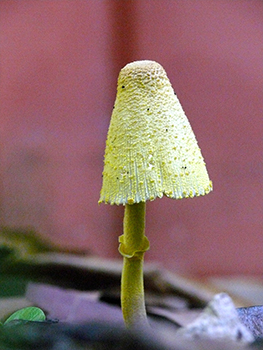Mushrooms, the reproductive organs of fungi, are everywhere during the rainy season of the islands and in different colors and sizes. Some appear in plant pots and disappear as quickly as they appeared. Others suddenly appear in the lawn or around dead branches or trunks. Others grow from still living tree stumps.
They are all speedy evidence of a complicated world, that develops and lives in rotting wood and in the soil. And usually the only parts of the fungi that are really clearly visible. The world of fungi is a very diverse world, with more than 100,000 officially identified and classified species. A number that can be adjusted annually with further scientific research and of which estimates indicate that this could amount to millions of species. In addition, fungi occur in the strangest locations, such as in deserts and in places where there is a high salt content in the soil. The diversity is also high on the ABC-islands, based on the many photos that have been taken of different species in the past 20 years. However, formal research has never been done on the fungi on the island, so we actually do not know much about this special kingdom in classification science. What we do know is that in the wet season, the rainy season at the end of the year, various types of fungi start to reproduce and form the well-known mushrooms. These mushrooms are the ’trucks’ for the spores with which the fungi reproduce.
There are some species on the island that we can identify more easily on the basis of data collected elsewhere. These are the so-called globetrotters, or fungi that ‘hitchhike’ to other places. The yellow mushrooms that often emerge from potting soil in potted plants are very appropriately called the Yellow parasol mushroom or Flower pot mushroom and is most likely the largest globetrotter of all, because it has spread practically worldwide. All thanks to humans who simply like to have plants in the house everywhere which are a great place to live for these delicate fungi beauties. By the way, this mushroom is not edible, and it is also advisable not to touch or eat other mushrooms. Too little is known about the species on the islands to make that without danger.
English name: Flower por parasol
Papiamentu name: –
Scientific name: Leucocoprinus birnbaumii
Occurrence (ABC islands): Aruba, Bonaire en Curaçao


De Gele parasolzwam
Paddenstoelen, de voortplantingsorganen van schimmels, ze zijn op het moment overal te vinden in verschillende kleuren en maten. Sommige komen in plantenpotten op en verdwijnen even snel als dat ze voor de dag zijn gekomen. Anderen staan in ineens in het gazon of rondom dode takken of stammen. Anderen groeien uit nog levende boomstronken.
Allemaal zijn het snelle getuigen van een ingewikkelde wereld, dat zich in rottend hout en in de bodem, ontwikkelt en leeft. En meestal de enige delen van de schimmels die echt goed zichtbaar zijn. De wereld van de schimmels is een zeer diverse wereld, met meer dan 100.000 officieel geïdentificeerde en geclassificeerde soorten. Een aantal wat jaarlijks kan worden bijgesteld met verder wetenschappelijk onderzoek en waarvan schattingen aangeven dat dit kan uitlopen tot miljoenen soorten. Daarnaast komen schimmels op de meest vreemde locaties voor, zoals bijvoorbeeld in woestijnen en op plekken waar een hoog zoutgehalte in de grond te vinden is. Ook op Curaçao is de diversiteit hoog, alleen al gebaseerd op de vele foto’s die van verschillende soorten is gemaakt in de afgelopen 20 jaar. Formeel is er echter nooit onderzoek gedaan naar de schimmels op het eiland, dus weten doen we eigenlijk niet zo veel over dit bijzondere rijk in de classificatiewetenschap. Wat we weten is dat in de natte periode, de regentijd aan het einde van het jaar, verschillende schimmelsoorten zich gaan voortplanten en daarvoor de bekende paddenstoelen vormen. Deze paddenstoelen zijn de ‘vrachtwagens’ voor de sporen, waarmee de schimmels zich voortplanten.
Er zijn wel wat op het eilandsoorten die we makkelijker kunnen identificeren aan de hand van gegevens die elders zijn verzameld. Het gaat dan om de zogenaamde globetrotters, of schimmels die ‘hitchhiken’ naar andere plekken. De gele paddenstoelen die vaak in potplanten uit potaarde opkomen heet heel toepasselijk de Gele paddenstoel en hoogstwaarschijnlijk de grootste globetrotter van allemaal, omdat het zich praktisch wereldwijd heeft verspreid. Allemaal dankzij de mens die nou eenmaal graag overal planten in het warme huis willen hebben die een prima woonplek zijn voor deze tere schoonheden. De paddenstoel is trouwens niet eetbaar, en het is ook aan te raden andere paddenstoelen niet aan te raken of op te eten. Er is te weinig bekend over de soorten op het eiland om dat mogelijk te maken.
Nederlandse naam: Gele parasolzwam
Papiamentse naam: –
Wetenschappelijke naam: Leucocoprinus birnbaumii
Voorkomen (ABC eilanden): Aruba, Bonaire en Curaçao